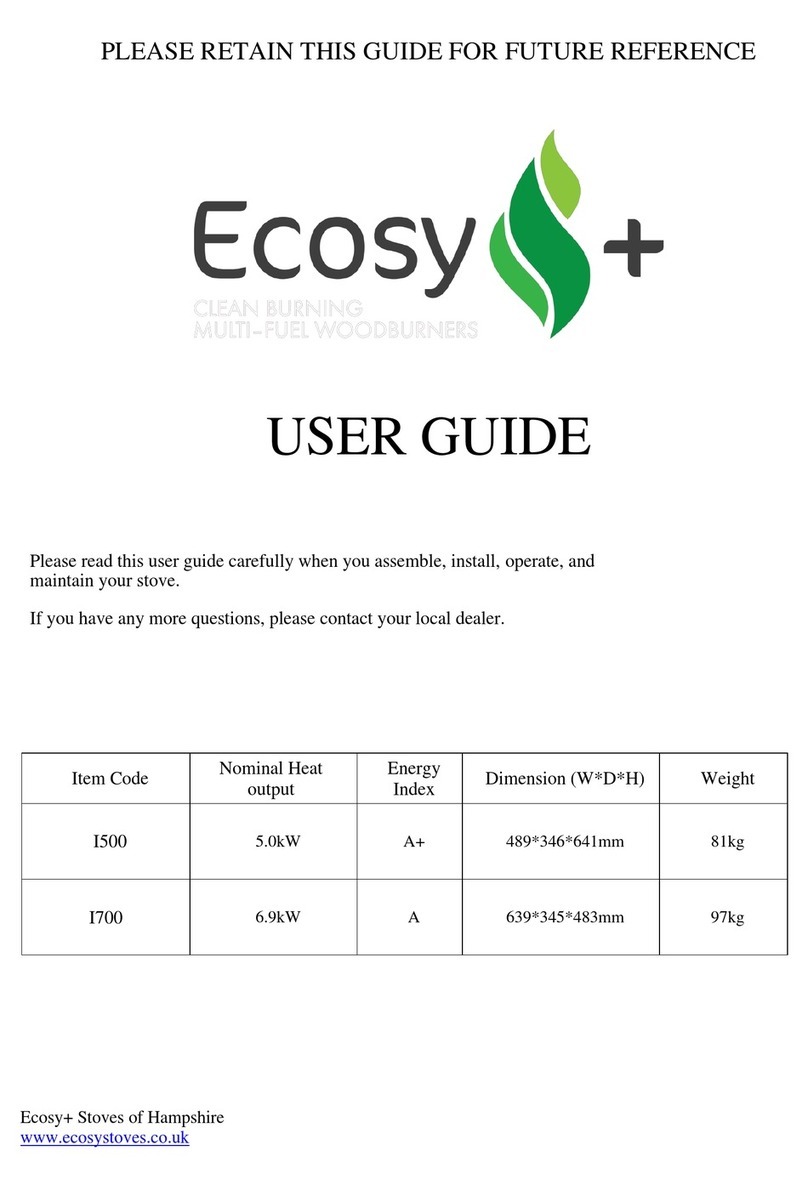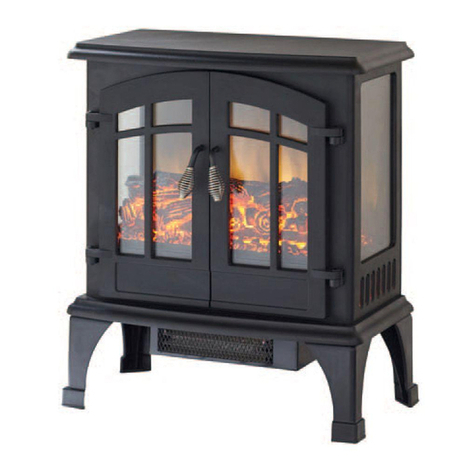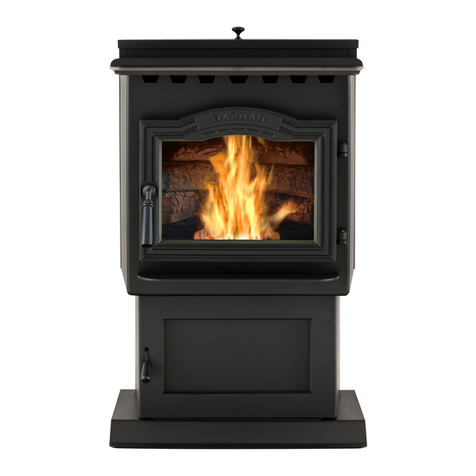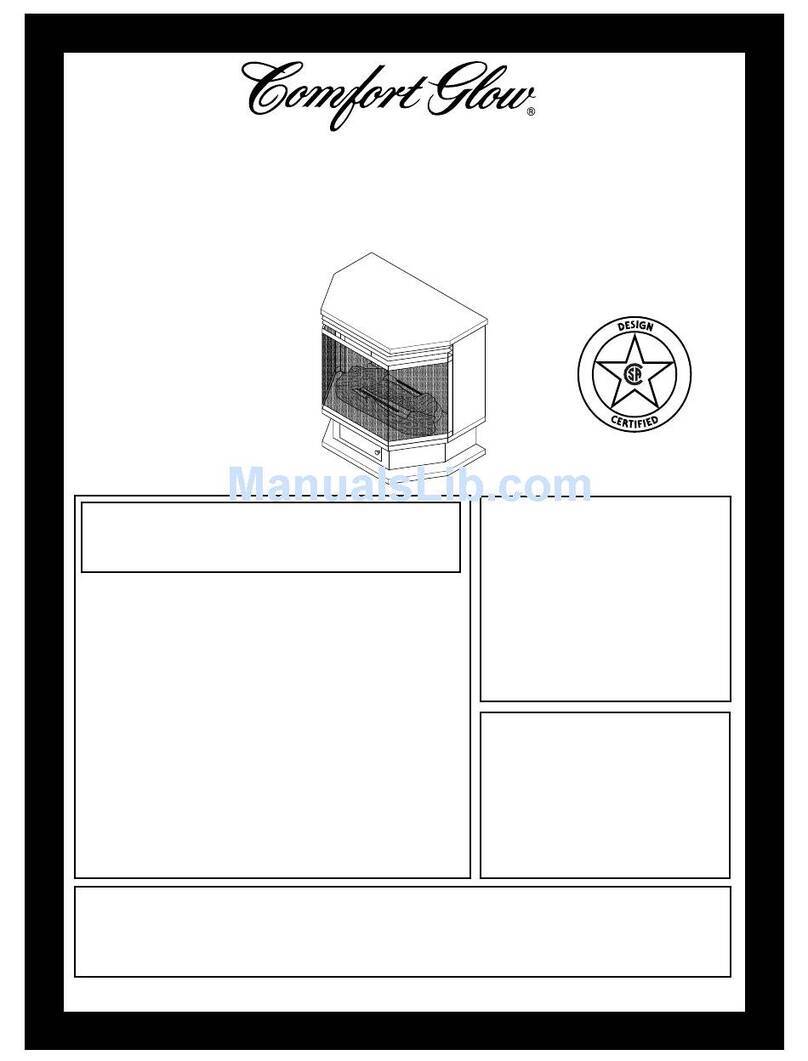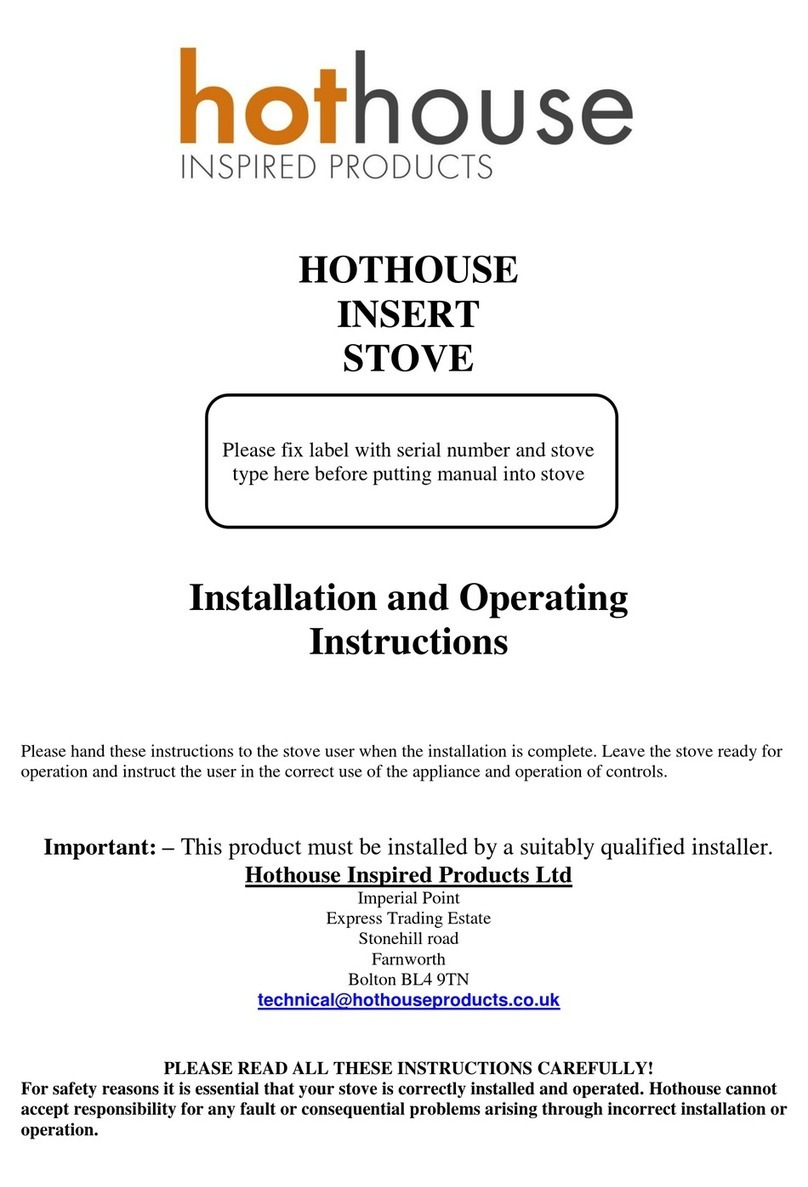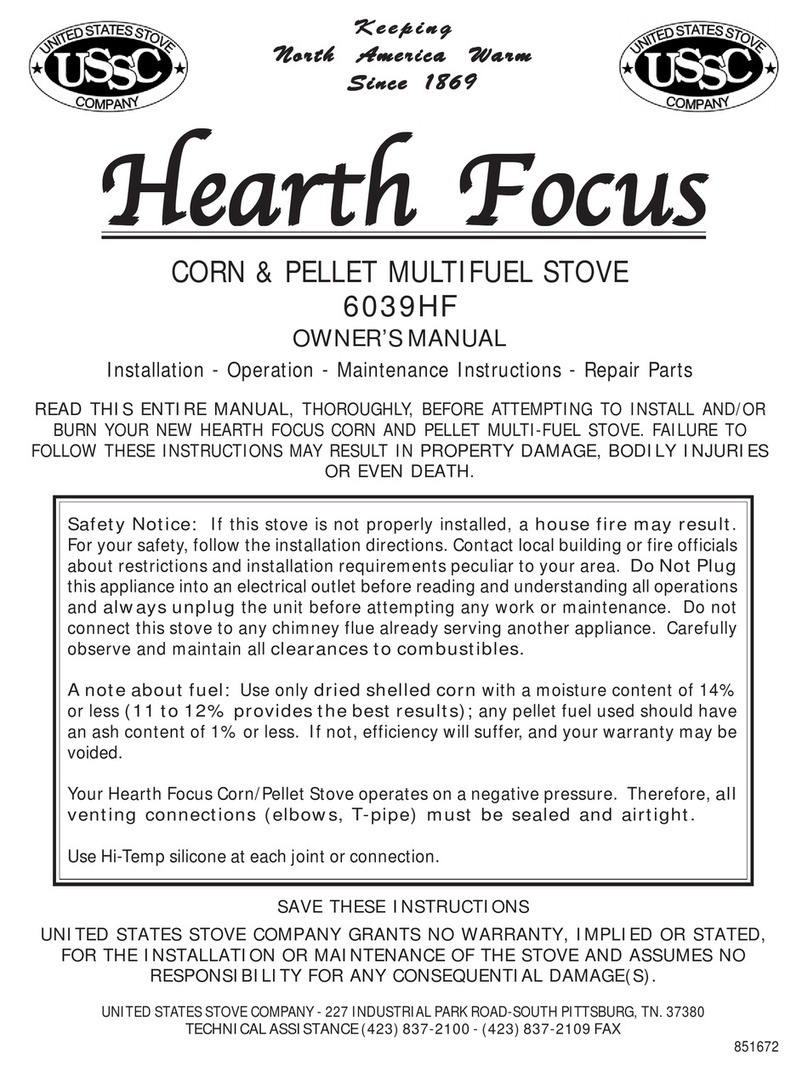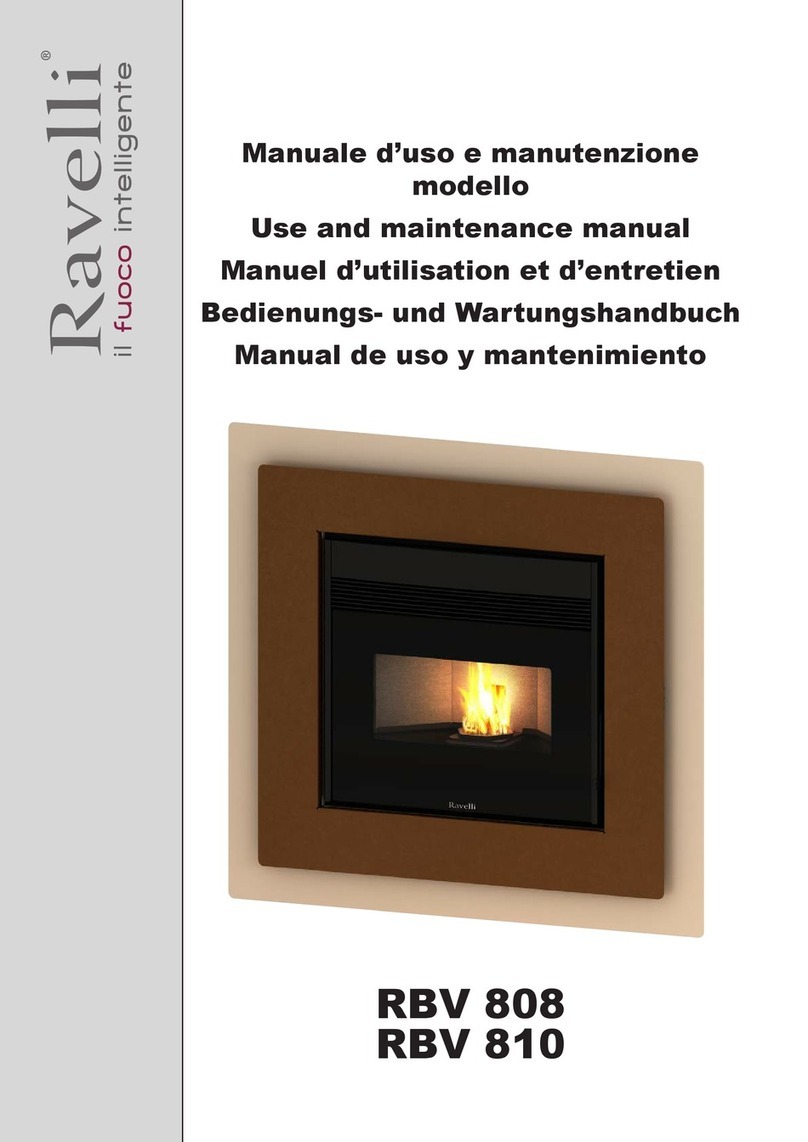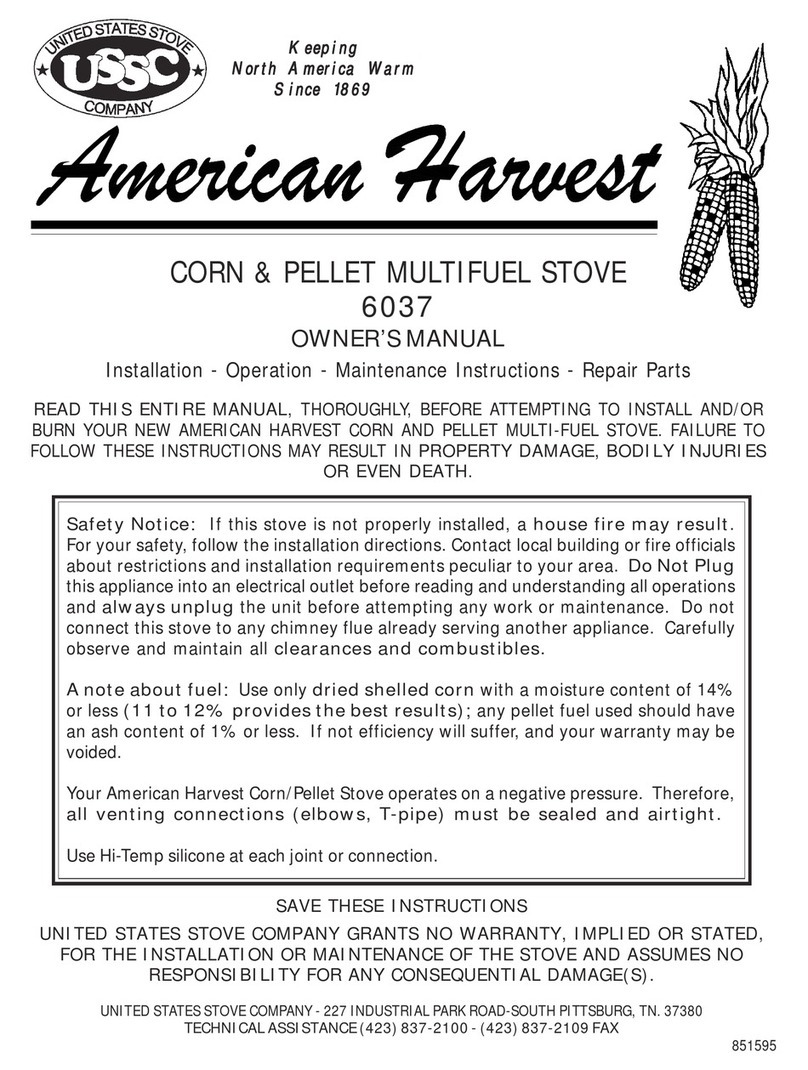Ecosy+ Snug 7 User manual

Page 1of 11
Snug 7 Stove
(Woodburning With Multi-Fuel Grate Option)
Version number 1: Issue date 14/08/2019
Model: Snug 7 Stove
Size: W470XD388XH619MM

Page 2of 11
INTRODUCTION
Wood-burning with multi-fuel option
Item No.: Snug 7
Size: W470XD388XH619 (mm)
SAFETY
Safety is the most important consideration when using and installing your stove. If not
installed and used correctly, a house fire could result. Installation must comply with
relevant national and local Building Regulations and fire safety standards.
IN THE EVENT OF A CHIMNEY FIRE, EVACUATE THE PROPERTY AND CALL THE
EMERGENCY
SERVICES.
Your stove will be heavy, and care needs to be taken when lifting - 2 people will normally be
required to lift.
UNPACKING
Your stove will have several of its components stored inside the stove itself for
transportation.
The main component is the flue collar; this will simply need attaching with the provided
bolts on the top or rear of the fire. Ensure you remove the free oven glove and any small
accessories that may be tucked away under the grate.
INSTALLATION
Installation of your stove must comply with relevant local and national Building Regulations
and fire safety standards. We would always suggest using a qualified installer to carry out
the installation of this product. The British recognised standard for solid fuel installations is
HETAS. You can find a HETAS qualified installer in your area by going to the HETAS website
–www.hetas.co.uk. If you are self-installing, the stove must be signed off by the local
authority.

Page 3of 11
TECHNICAL
Snug 7 - Performance Test Results.
Weight 80kg
Test Fuel
Wood Logs
Maxibrite
(Optional Grate)
Total Efficiency (%)
80.8
77.7
Nominal heat output (kW)
7.1
7.3
Mean CO emission (@13% O2)
0.08
0.08
Flue gas mass flow (g/s)
4.3
5.4
Mean CnHm(at 13 % O2) Nmg/m3
89
31
Mean NOx (at 13 % O2) Nmg/m3
96
105
DIN Plus dust (at 13 % O2) Nmg/m3
28
29
Suitable for a direct air feed / Sealed air –100mm spigot on the stoves rear.
Distances to combustible materials:
Back Wall –650mm
Side Wall –700mm
Hearth Temperatures
Maximum hearth temperature –79c
This stove is suitable for a 12mm hearth. For example, a 12mm glass hearth can sit directly
onto a wooden floor and this unit can be sat on top of that.
Your stove will require a constant air supply and should not be used at the same time or in
the same room/space as extractor fans or any device which may draw air supply away from
the stove. The stove should be installed on a level floor with adequate load bearing capacity.
The stove does include adjustable feet for levelling.
Normally for most houses in the UK, no extra ventilation is required when installing a stove
rated at 5kW or less.
Note: The requirements regarding ventilation have been updated in the most recent
version of the Building Regulations and are now based on the air permeability of the house.
The stove is NOT suitable for installation in a shared flue system.
The flue pipe must be fitted INSIDE the flue spigot and sealed with a generous amount of
Fire Cement. A 5”flexible flue liner or twin walled chimney system can be used with this unit,
as it has passed the DEFRA testing.

Page 4of 11
Access should be provided for cleaning the flue to ensure that the passageways for exhaust
gases remain free from obstruction.
OPTIONAL EXTRAS
•Multi-Fuel Grate –Your stove will come as standard with a Wood-burning only style of
flat grate. You are only permitted to burn dry seasoned wood and no other fuels on this
style of grate that comes with the stove. We also offer a Multi-fuel grate if you are wanting
the option of burning smokeless coal. The two grates simply lift in and out and are not fixed
into the unit, giving great flexibly and the best efficiency for each fuel.
•Vertical Flue Box –This flue box can be bolted to the stoves rear and enables you to
position the stove further into the room; away from the wall. This box can make
installations easier and does not push the stove out as far as 90-degree T pieces. The flue
box cannot be used at the same time as the heat shield (above)
OPERATING INSTRUCTIONS
Regulations
All National and local regulations, including those referring to National and European
standards, need to be complied with when installing the stove.
The Clean Air Act 1993 and Smoke Control Areas
Under the Clean Air Act local authorities may declare the whole or part of the district of the
authority to be a smoke control area. It is an offence to emit smoke from a chimney of a
building, from a furnace or from any fixed boiler if located in a designated smoke control
area. It is also an offence to acquire an “unauthorised fuel” for use within a smoke control
area unless it is used in an “exempt” appliance (“exempt” from the controls which generally
apply in the smoke control area).
In England appliances are exempted by publication on a list by the Secretary of State in
accordance with changes made to sections 20 and 21 of the Clean Air Act 1993 by section
15 of the Deregulation Act 2015. Similarly, in Scotland appliances are exempted by
publication on a list by Scottish Ministers under section 50 of the Regulatory Reform
(Scotland) Act 2014. In Northern Ireland appliances are exempted by publication on a list
by the Department of Agriculture, Environment and Rural Affairs under Section 16 of the
Environmental Better regulation Act (Northern Ireland) 2016. In Wales appliances are
exempted by regulations made by Welsh Ministers.
Further information on the requirements of the Clean Air Act can be found here:
https://www.gov.uk/smoke-control-area-rules

Page 5of 11
The Ecosy+ Snug 7 has been recommended as suitable for use in smoke control areas
when burning seasoned wood logs. The appliance has a factory-fitted modification to the
secondary air control to prevent closure beyond 5mm open position at the vent opening.
Your local authority is responsible for implementing the Clean Air Act 1993 including
designation and supervision of smoke control areas and you can contact them for details of
Clean Air Act requirements.
Please note the following advice on minimising smoke emissions:
Refuelling on to a low fire bed
If there is insufficient burning material in the fire bed to light a new fuel charge, excessive
smoke emission can occur. Refuelling must be carried out onto a sufficient quantity of
glowing embers and ash that the new fuel charge will ignite in a reasonable period. If there
are too few embers in the fire bed, add suitable kindling to prevent excessive smoke.
In order to establish and maintain flames on a new refuel charge, it is necessary to operate
with the door ajar for a period of 1- 3 minutes.
Fuel overloading
The maximum amount of fuel specified in this manual should not be exceeded, overloading
can cause excess smoke.
Dampers Left Open - Operation with the air controls or appliance dampers open can
cause excess smoke. The appliance must not be operated with air control, appliance
dampers or door left open except as directed in the instructions.
FUEL
Wood- All types of wood are suitable provided they are well seasoned, UNTREATED, and
have a moisture level between 12% and 20%. For soft woods, typically they will need to
have been left in suitable storage for 9+ months for the moisture to evaporate. For
hardwoods, this will usually be 18 months+. It is recommended that logs should be no
more than 5” (125mm) in diameter and 8” (200mm) in length. If you are unsure of the
moisture content of your fuel, then you can buy a moisture meter which will indicate the
moisture levels in your fuel. Liquid fuels must NEVER be used.
WARNING: Wet timber should not be used as this will create excess tar deposits in the
chimney and stove and could increase the risk of chimney fire. Timber which is not of a
suitable moisture content will also create more smoke and harmful emissions, and will
damage the stove and flue system.

Page 6of 11
Solid Fuel –(Please ensure Multi-Fuel grate is installed before burning smokeless coal)
Solid mineral fuel should be placed in the stove so that there is no more than a 30° incline
of the fuel bed from front to back. It should not be stacked above the level of the rear
firebrick as this may result in damage to the stove.
Always de-ash before refuelling and do not let the ash build up to the underside of the grate
bars. Solid mineral fuel produces ash, which if allowed to build up will stifle the airflow
through the Primary air sliders and grate. This will eventually cause the fire to go out.
With some solid mineral fuels, a residue of burnt fuel or clinker will accumulate on the grate
- allow the fire to go out periodically to remove this.
Important! - We cannot stress firmly enough how important it is to empty the ashpan
regularly. Air passing through the fire bed cools the grate bars. Distortion or burning out the
grate bars is nearly always caused by ash being allowed to build up to the underside of the
grate. Anthracite is an approved natural smokeless fuel (not processed) and therefore can
vary greatly in quality and performance. It generally requires excellent air supply and above
average fire-bed temperatures to maintain maximum performance and with experience we
would suggest that it is used in conjunction with other approved manufactured smokeless
fuels as per the HETAS approved list http://www.hetas.co.uk/find-fuels/ . Smokeless fuels
AIR INLET CONTROLS
The base control lever on the right controls the rate of primary air flowing under the fire.
Having this lever to the left reduces the amount of air and to the right increases the
amount of air drawn into the stove. If you have the woodburning grate installed, we only
suggest having this vent open when first lighting the fire. When the fire is established, we
would suggest closing this off fully as wood burns best with air flowing over the top of it
as opposed to underneath. If you have the Multi-Fuel grate in place this lever will be used
a lot more as mineral fuels like a lot of air flowing under them and very little flowing over
the top of them.
The base control on the left controls the airwash system and secondary burn system.
When pushed to the right, this feeds more air through the stoves rear. The air is fed over
the fire reburning the initial smoke produced from the stove. The air is also warmed and
fed over the glass helping to keep it clean. When pushed to the left this is restricted. When
you have the Woodburning grate installed you will use this lever to control the burn rate
of the fire. If you have the Multi-fuel grate installed, you will have the vent almost closed
and control the burn rate with the primary lever.
It is often a case of trial and error to get the maximum performance from the stove as
every installation and chimney is different.
TOOLS

Page 7of 11
The glove is provided for adjusting the air inlets and for opening the door when the stove is
hot, as these knobs will heat up when in use. The tool handle provided is for removing the
ash-pan.
NOTE –all parts of the stove will become hot during use and care needs to be taken to
avoid injury through burning.
LIGHTING THE FIRE AND RE-FUELING
Prior to lighting the fire for the first time, ensure that-
Installation and building work is complete.
The chimney is suitable and sound and has been swept and free from obstruction.
Adequate ventilation and provision for combustion air has been made.
That the stove installation has been carried out in accordance with Building Regulations
and any applicable local regulations as well as these installation instructions.
That chimney draw has been checked and within specification. (The stove has been
tested at nominal output with a flue draught of 12 Pa) INITIAL CURING AND TEMPERING
FIRES
ESSENTIAL INSTRUCTIONS BEFORE USE –It is essential to follow these ‘tempering in’
instructions in order to avoid serious damage to your stove. The castings of your stove
require very gentle ‘normalising’ to release stresses in the metal formed during the casting
process. The paint finish also requires an initial curing process to be followed: -
For the first 2 burns on day one just use small controlled kindling wood fires with each fire
lasting around 40 minutes –the second fire can be started when the stove is almost cooled
down after the first. A third slightly hotter medium type fire should then be lit using smallish
logs and lasting around 1 hour. Then for the next week or around 15-20 hours total burn
time, fires must be gently increased in temperature and log size and load and NO
SMOKELESS COAL must be used during this period. A stove thermometer will be a valuable
tool in helping you to achieve this safely and also to ensure an efficient burn rate in future.
Starting a large fire too soon is likely to damage the stove in which case it will not be
covered by the warranty. Note: the paint on any new stove is relatively soft. As such do not
clean, wash or
wipe the surface until the paint has fully cured. Never wipe the stove whilst warm. If the
above advice is ignored then there is a high risk of the paint being “shocked” by excessive
heat and could peel. Furthermore, if the stove is over fired it will invalidate your guarantee.
ENSURE THAT YOU HAVE READ AND UNDERSTOOD THESE INSTRUCTIONS BEFORE
LIGHTING THE FIRE AND THAT YOU ARE CONFIDENT THE STOVE HAS BEEN INSTALLED
CORRECTLY.
ALWAYS WEAR A PROTECTIVE GLOVE WHEN REFUELLING YOUR STOVE.
Ignition (FOLLOW INITITAL TEMPERING INSTRUCTIONS ABOVE FIRST TO AVOID
DAMAGE)
Ensure the ash-pan is in place. Ensure all air inlets are fully open (tertiary air should be
closed for first 3 burns)
Construct a pile of kindling in the middle of the grate using approx 500g of kindling wood

Page 8of 11
Light with a single chemical firelighter
Partially shut the door but leaving it cracked open slightly
After about 5 minutes or when the fire is well established, shut the door
After a further 3-5 minutes as the fire starts to die, add a further three larger pieces of
wood weighing approx. 0.75kg in total.
Once theses logs are alight, and after about 7 minutes or so, a normal load of 3 logs
weighing up to 1.4kgs in total can be added (ONLY AFTER THE INITIAL TEMPERING
PERIOD HAS BEEN FOLLOWED –SEE ABOVE)
First use troubleshooting.
When the stove is new the paint is very tacky where the stove is curing. The door locks very
tight and when opened can pull away the fire rope from its chamber. If the instructions are
followed above this should not happen. if it does, the rope will need to be stuck back in
place with “heat resistant fire rope glue” After a few burns the paint will be cured and this
should no longer happen.
Refuelling
When re-fuelling the stove, it is necessary to fully open both the primary and secondary air
controls for a period of 3 minutes to establish the fire before closing down to the minimum
output setting.
At high power output, your stove will require refuelling approximately every hour.
It is important to follow these instructions in order to achieve clean burning and to
maximise the efficiency of the stove
Do not leave the fire unattended until flames are well established on the newly charged
logs
Always refuel onto hot embers.
If the fire has died out at the point of refuelling, use kindling to re-establish the fire and
follow the “Ignition” procedure above.
It is important that the stove is not overloaded with fuel.
Reduced burn rates can be achieved by reducing the openings of the Secondary and
Tertiary air vents.
Refuelling on to a low fire bed –If there is insufficient burning material in the firebed to
light a new fuel
charge, excessive smoke emission can occur. Refuelling must be carried out onto a
sufficient quantity of
glowing embers and ash that the new fuel charge will ignite in a reasonable period. If there
are too few embers in the fire bed, add suitable kindling to prevent excessive smoke.
Fuel overloading - The maximum amount of fuel specified in this manual should not be
exceeded, overloading can cause excess smoke.
Operation with door left open –Operation with the door open can cause excess smoke. The
appliance must not be operated with the door left open except as directed in the
instructions.

Page 9of 11
The Ecosy+ Snug 7 stove is suitable for use in smoke control areas when used in
accordance with these instructions.
WARNING- The high temperature paint covering the stove will give off some fumes during
the initial few uses of the stove. The fumes are non-toxic, but some people may find them
unpleasant –Ensure the area is well ventilated during this period. The higher power output
rating of this stove is based on around 1.4kg of seasoned logs which would require
refuelling every hour.
Under certain abnormal weather conditions, e.g. down draughts, it may be difficult to get
enough draw through the appliance to achieve good combustion. When this happens, the
stove should not be used.
IMPORTANT: -
As of October 2010, it is a legal requirement to use a Carbon Monoxide Detector in the
same room as the stove. This needs to incorporate a battery which lasts the life of the
detector.
CLEANING/MAINTENANCE
When cold, the inside of the stove should be given a regular sweep out.
The flue and flue pipe will require cleaning with a suitable chimney brush, to minimise
build-up of soot and tar. Your chimney will also require periodic sweeping.
If the glass becomes stained from the inside, the air-wash vent may need opening more
during use. If the vent is fully open and the glass is still going black it will most likely be
down to poor quality wet wood. The high temperature paint which your stove is finished in
should last many years with normal use, but when it does eventually require re-finishing,
black heat resistant paint in spray cans can be purchased from most hardware stores but
we would suggest using “Calfire flat black paint”. – Do not use regular paint which is not
high temperature resistant. After prolonged periods of not using the fire, the stove and flue
system should be checked for blockages prior to relighting. We recommend regular
servicing and safety checks are carried out by a qualified engineer. There must be no
unauthorised modification of the appliance. Use only replacement parts recommended by
the
manufacturer.
CLEANING THE GLASS - Just use a clean cloth with warm water or specialist stove glass
cleaner. You must ensure the stove is cold before cleaning the glass. It is very important
that the glass is 100% dry before the stove is lit again. If you do not follow these
instructions, your glass couls “craze”. Crazing can also occur if incorrect fuels are burnt on
the stove or if fuels with impurities or high moisture in them are used. Broken or crazed
glass is not covered under any guarantee for any period of time.
FIRE BRICKS

Page 10 of 11
If fire bricks have just split, they do not need replacing. The bricks only need replacing
when they have fully crumbled away exposing the stoves rear or sides. Fire bricks are fully
heat resistant but can easily split if struck with a log or other similarly hard object.
GUARANTEE
The main body of your stove is guaranteed for 5 years. This does not include broken glass,
Crazed glass, fire bricks, door seals, grates, ash pans, paint and over-firing.
Incorrect use or installation not carried out by a registered HETAS installer will void the
guarantee. The only exceptions will be if the install has been signed off by your local
authority. Please keep hold of the invoice as this will be requested if a claim is started. If
this is not provided upon request, we will not be able to escalate your claim. The guarantee
will begin from the sale date on the invoice and we do not cover any cost incurred when
removing faulty appliances or installing new ones, even if it has been proven that the stove
is faulty. For full guarantee details please visit www.ecosystoves.co.uk

Page 11 of 11
DRAWINGS
-
Ecosy+, Unit 22-26 –Folly farm, Ramsdell, Tadley, RG26 5GJ
Table of contents
Other Ecosy+ Stove manuals
Popular Stove manuals by other brands
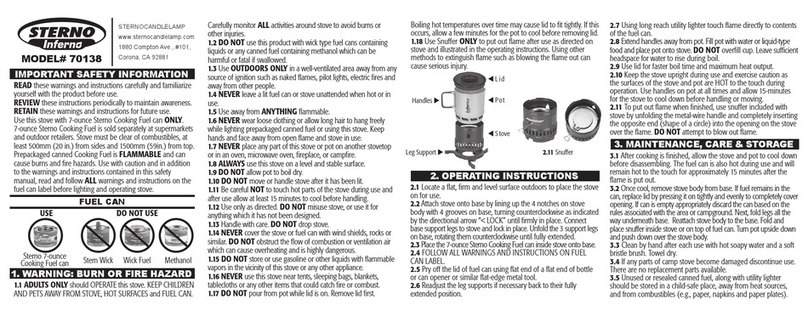
Sterno Inferno
Sterno Inferno 70138 instruction manual

Arada
Arada Stratford Ecoboiler user guide

Piazzetta
Piazzetta MT 361 Installation, use and maintenance instructions

Hunter Stoves
Hunter Stoves AVALON 4 Instructions for Installation/Operating/Maintenance/Servicing

Morsø
Morsø 1410 Installation and operating instructions
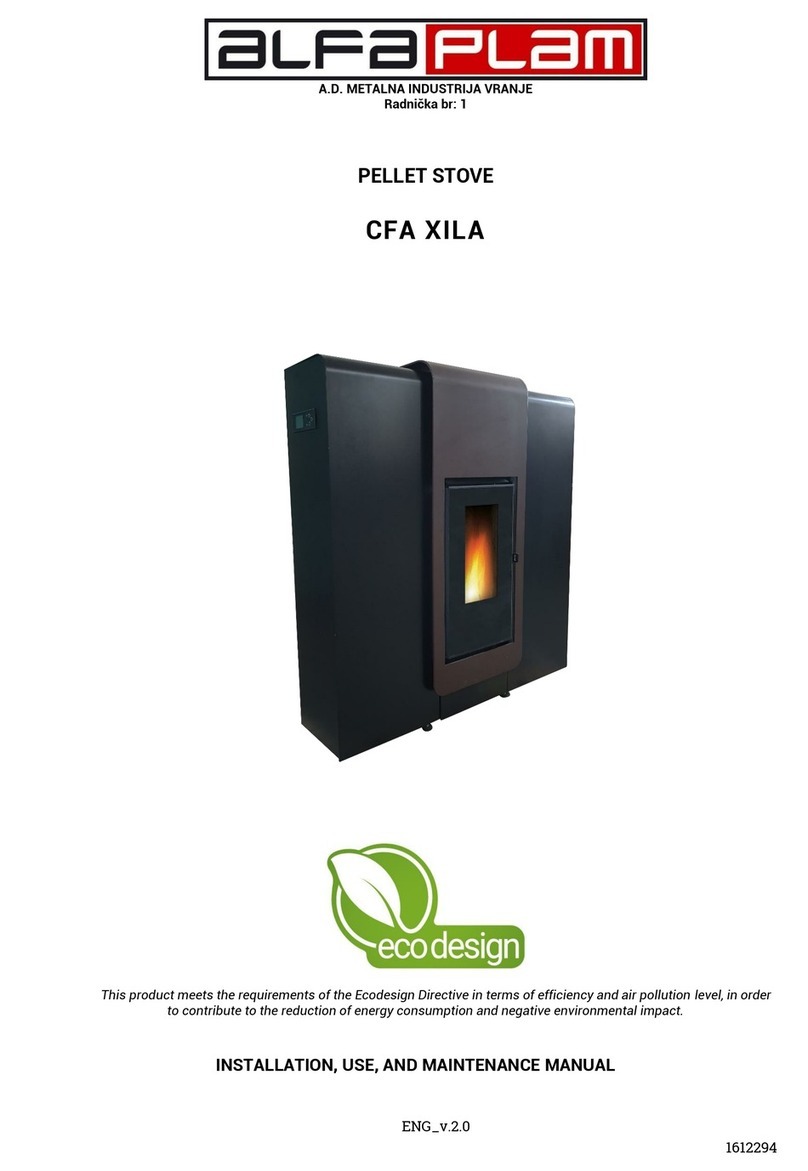
Alfa Plam
Alfa Plam CFA XILA Instructions for installation, use and maintenance manual

